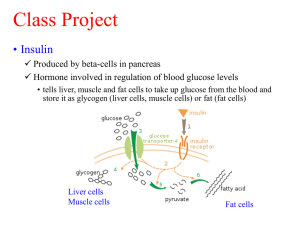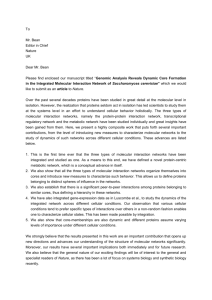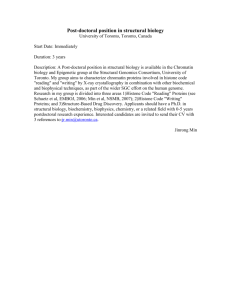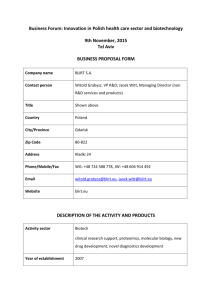Roger Tsien - Australian Society for Biochemistry and Molecular
advertisement
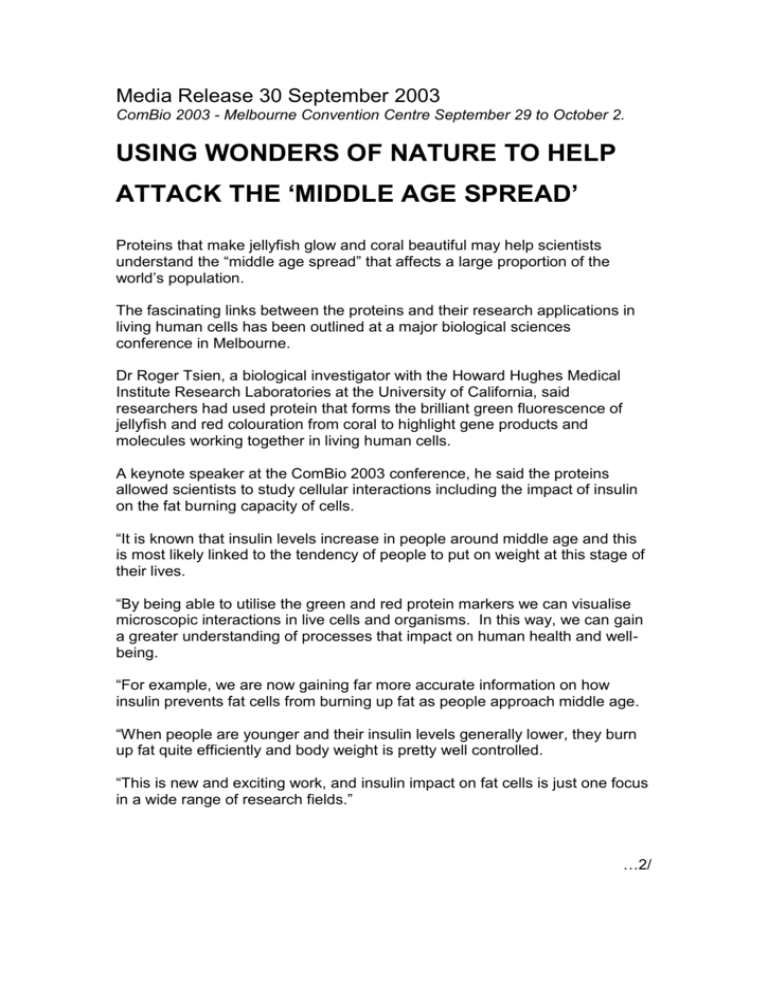
Media Release 30 September 2003 ComBio 2003 - Melbourne Convention Centre September 29 to October 2. USING WONDERS OF NATURE TO HELP ATTACK THE ‘MIDDLE AGE SPREAD’ Proteins that make jellyfish glow and coral beautiful may help scientists understand the “middle age spread” that affects a large proportion of the world’s population. The fascinating links between the proteins and their research applications in living human cells has been outlined at a major biological sciences conference in Melbourne. Dr Roger Tsien, a biological investigator with the Howard Hughes Medical Institute Research Laboratories at the University of California, said researchers had used protein that forms the brilliant green fluorescence of jellyfish and red colouration from coral to highlight gene products and molecules working together in living human cells. A keynote speaker at the ComBio 2003 conference, he said the proteins allowed scientists to study cellular interactions including the impact of insulin on the fat burning capacity of cells. “It is known that insulin levels increase in people around middle age and this is most likely linked to the tendency of people to put on weight at this stage of their lives. “By being able to utilise the green and red protein markers we can visualise microscopic interactions in live cells and organisms. In this way, we can gain a greater understanding of processes that impact on human health and wellbeing. “For example, we are now gaining far more accurate information on how insulin prevents fat cells from burning up fat as people approach middle age. “When people are younger and their insulin levels generally lower, they burn up fat quite efficiently and body weight is pretty well controlled. “This is new and exciting work, and insulin impact on fat cells is just one focus in a wide range of research fields.” …2/ -2Dr Tsien is internationally acclaimed for his research work in organic chemistry and cell biology and in the development of ways to find candidate drugs for the pharmaceutical industry. “Visualisation of gene products and small molecules working together in space and time to form living cells and organisms has become particularly important in this post genomic era,” he said. “We know that jellyfish develop a deep green glow when they are alarmed, but we do not fully understand the processes behind this fluorescence. “There are also a number of theories about why coral develops such a rich red colour with some suggesting it helps protect the organism from excessive sunlight. “We have been able to source the proteins that create these colours in jellyfish and coral and modify them for wide ranging cell research in humans and animals. “In effect, we have modified the proteins into molecular spies that go into cells and report back what is happening. “We train these molecular spies to observe and report on processes occurring in cellular life. “Ultimately, it may help us to develop preventive strategies and treatments to address a wide range of illnesses and conditions affecting vast numbers of people.” More than 1200 scientists and researchers from around the world have gathered at the Melbourne Convention Centre for ComBio 2003, a joint meeting of the: Australian Society of Biochemistry and Molecular Biology; Australia and New Zealand Society for Cell and Developmental Biology; Australian Society of Plant Scientists; New Zealand Society for Biochemistry and Molecular Biology; and New Zealand Society of Plant Physiologists. The conference will run until Thursday. For interview: Dr Roger Tsien is returning to the United States on Tuesday 30 September. However, he can be contacted for interview. To arrange, please call Trevor Gill on 0418 821948



